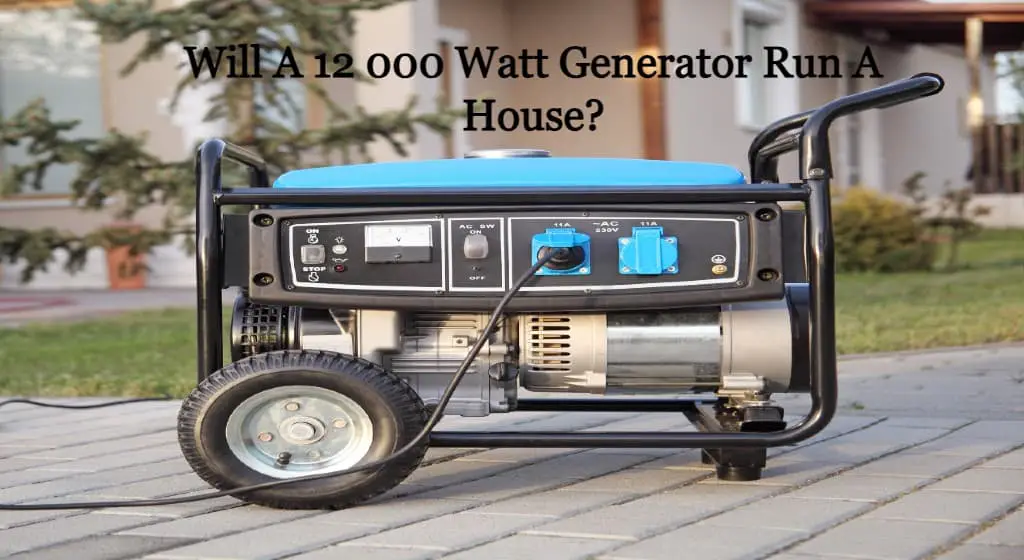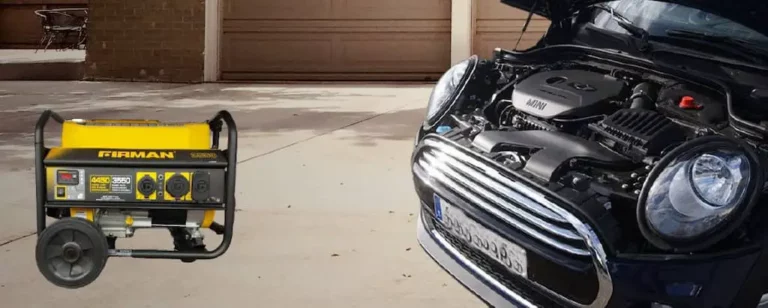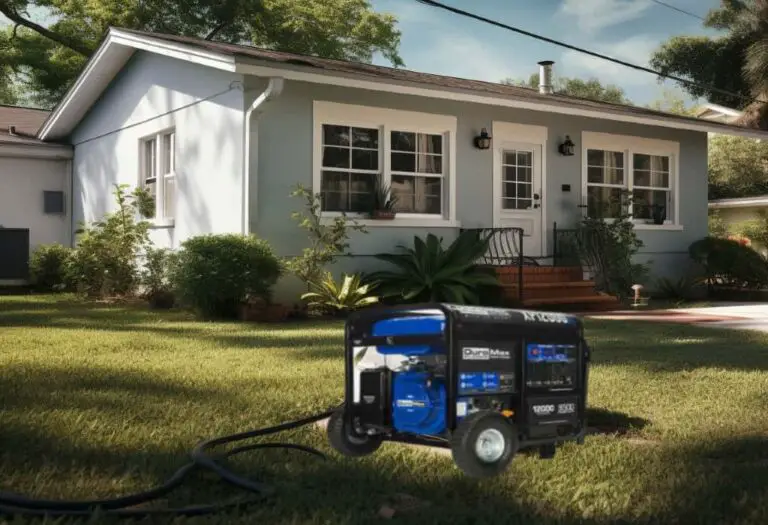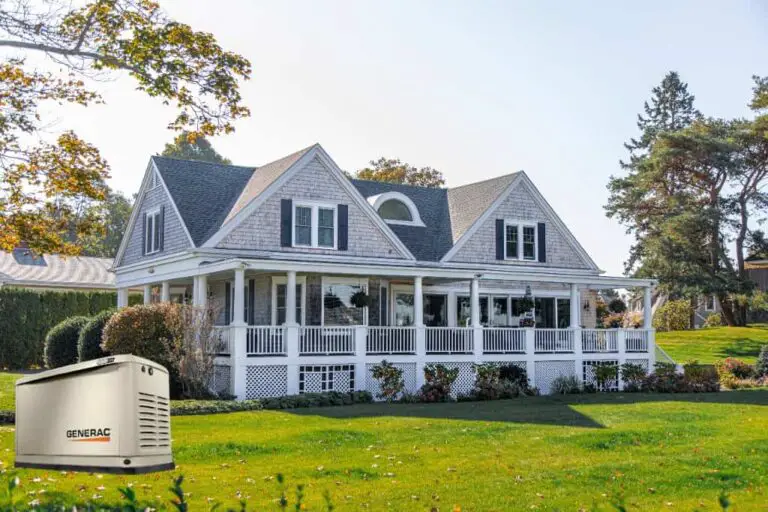Run A House with 12,000 Watt Generator

A 12,000-watt generator can potentially power an entire house, given that the average home typically requires between 5,000 to 10,000 watts to run essential appliances. If you’re considering using one for your home, you need to calculate the total wattage of all the appliances you plan to use simultaneously, including refrigerators, air conditioners, and lights. Adding a 10-25% safety margin to your total wattage calculation is also advisable to handle unexpected power surges. But will this generator meet your specific needs, and how efficiently can it run your appliances? The answer depends on several key factors.
Power Output Capabilities
When considering a 12,000 watt generator for your house, understanding its power output capabilities is vital. These generators can produce up to 15,000 starting watts, though the standard is often around 12,000 starting watts, and typically provide either 9,000 or 12,000 running watts. This continuous power is sufficient to run most of your household appliances and tools.
The voltage output of these generators is versatile, allowing you to switch between 120V and 240V, making them suitable for a wide range of devices. The Total Harmonic Distortion (THD) levels are usually standard, guaranteeing safe usage with sensitive electronics like laptops, cell phones, and other digital devices.
In terms of appliance powering, a 12,000 watt generator can handle multiple household appliances simultaneously, such as air conditioners, refrigerators, microwaves, and even electric dryers. It is also capable of powering heavy-duty tools on a worksite, including electric drills, saws, and welders. For off-grid living, these generators are ideal for powering appliances in homes and RVs, especially those with 50-amp services that require higher power capacities. However, it’s important to calculate the total load to avoid overloading and maintain smooth operation, keeping a 10% margin under the maximum load for longevity and efficiency.
Home Backup Power Needs
To guarantee your home remains powered during outages, assessing your backup power needs is essential. Start by performing an electrical load calculation to determine the total wattage your home requires. List all the essential appliances you need to power, such as refrigerators, lights, medical devices, and heating or cooling systems, and note their respective wattage requirements. Don’t forget to take into account both the running and starting wattage for appliances that require extra power to start.
Review historical data on power outages in your area to understand the average duration and frequency of outages. Plan for worst-case scenarios, like those caused by severe weather events or natural disasters. This will help you decide how many hours of backup power you need for each appliance and calculate the total watt-hours required.
When selecting a backup power system, ensure it can handle your total wattage needs and provide enough runtime. For generators, take into account fuel efficiency and tank size. For battery backup systems, ensure the total battery capacity meets your kilowatt-hour requirement. Hybrid systems combining solar panels, batteries, and generators can offer sustainable and long-term solutions.
Additionally, consider the importance of continuous power for critical needs such as medical or business operations, as this will influence the type and capacity of the backup power system you choose.
Appliance Compatibility
Evaluating the compatibility of your appliances with a 12,000-watt generator is vital to confirm seamless operation during power outages. This generator can efficiently run most of your home appliances, but it’s important to check the running and starting wattage of each device.
For major appliances, a 12,000-watt generator can handle central air conditioners (1000 to 4000 watts), window AC units (1000 to 1400 watts), and refrigerators (typically around 1000 watts). It can also power dishwashers (1200 to 1400 watts), microwaves (900 to 1600 watts), and ovens (though ovens often require higher wattage, around 2100 watts, so check your specific model). Central heating furnaces generally consume less power (350 to 400 watts), making them easily manageable.
For construction and off-grid use, this generator can supply power to various tools like drills, benders, and rebar cutters. It’s also suitable for charging sensitive electronics such as laptops (100-150 watts) and cell phones, thanks to its less than 5% THD output. Additionally, it can run lights (60-75 watts), flat-screen TVs (50 to 120 watts), and even portable electric fan heaters (2000 to 3000 watts), though you’ll need to balance the load to avoid overloading the generator. By calculating the total wattage of your appliances, you can verify your 12,000-watt generator meets all your power needs efficiently.
When selecting a 12,000-watt generator, it is crucial to consider the starting watts required for initial appliance startup to ensure the generator can handle the surge power needs.
Features
| Part Number | XP12000EH |
| Model | XP12000EH |
| Warranty | 3-Year Limited Manufacturer's Warranty |
| Color | Black and Blue |
- With 12,000 watts of power, the XP12000EH Dual Fuel generator will keep your whole home running during a storm or power outage
- DuroMax is the industry leader in Dual Fuel portable generator technology, with a full assortment ranging from digital inverters to generators that can power your entire home
- At the core of all our products resides a robust DuroMax engine. Designed for Power. Designed to Last
- The XP12000EH comes equipped with a wide variety of outlets, including a transfer switch-ready 50 amp outlet. This generator features our MX2 Power Boost, which doubles the 120V power for appliances and RVs
- Constructed with a heavy-duty all metal frame and power panel - No plastic parts
- Built to withstand severe weather and years of heavy wear-and-tear
- Power wherever and whenever you need it - No-flat tires roll easily over any terrain
- 100% Copper Windings - Unlike aluminum, copper is a superior heat conductor that extends the life of your generator
- Stay powered with our EH line of portable generators
- DuroMax portable generators are designed to be mobile and versatile, with the ability to provide power whenever and wherever you need it. Unlike traditional standby generators that are large, expensive, yet only serve one purpose, DuroMax generators will power you whether you’re at home, on an RV trip, or at the jobsite
Electric Start and Remote Options
A 12,000-watt generator with electric start and remote options offers a significant boost in convenience and reliability for your power needs. With an electric start, you can power up your generator with just the push of a button, eliminating the need for physical effort required by traditional pull-start mechanisms. This feature is particularly beneficial for those who may have difficulty with manual starting or need a quick power supply during emergencies.
The remote start option takes convenience to the next level. You can turn your generator on or off using a key fob, allowing you to start it from the comfort of your home, RV, or tent without having to venture out into inclement weather. This remote control capability is especially handy during power outages or when you’re in a situation where leaving your shelter is inconvenient or risky. Additionally, the remote start feature ensures you can operate the generator from a distance, enhancing safety and comfort.
Additionally, electric start and remote start generators often come with advanced safety features such as automatic low-oil shutdown and overload protection, ensuring the longevity and safety of the generator. These generators also provide stable power quality, making them suitable for sensitive electronics, and some models offer smart idle features to enhance fuel efficiency and reduce noise levels.
Run Time and Fuel Efficiency
- Efficiency and Wear: Generators are most efficient when they operate between 50% and 80% of their rated capacity. Running a generator at a low load (e.g., 50%) can lead to reduced efficiency, increased fuel consumption, and potential damage to the engine and alternator due to incomplete combustion and carbon build-up.
- Fuel Consumption: At 50% load, a generator consumes more fuel per unit of energy produced compared to when it is run at full or near-full capacity. For example, a generator might consume 0.23 gallons per kilowatt at 50% load versus 0.17 gallons per kilowatt at full load.
- Lifespan: Continuous operation at high loads can reduce the generator’s lifespan, while low-load operation can also lead to premature wear and tear on key engine components.
- Electric Start: Generators equipped with an electric start capability can be activated quickly, which is beneficial for immediate power needs during emergencies.
Fuel Type Considerations
- Gasoline models can run up to 11 hours at 50% load with a 10.5-gallon tank, while propane models may offer up to 6 hours at 50% load with a 20 lb. tank.
- Dual fuel models provide flexibility, allowing you to switch between gasoline and propane, which can be beneficial depending on your specific needs.
Safety Features and Regulations
To guarantee safe and compliant operation of a 12,000-watt generator, it is crucial to adhere to several key safety features and regulations.
First, never attach the generator directly to your home’s electrical system unless a qualified electrician has properly installed it with a transfer switch. This prevents electrocution risks to both you and utility workers. Confirm the generator is properly grounded, and the grounding connections are tight, following the manufacturer’s instructions.
When using the generator, always plug electrical appliances directly into it using the manufacturer’s supplied cords or grounded (3-pronged) extension cords. Inspect these cords to confirm they are intact and not damaged. Avoid overloading the generator, as this can lead to overheating and fire hazards.
For carbon monoxide safety, keep the generator outside with 3 to 4 feet of clear space around it for adequate ventilation. Never use generators or similar devices indoors, as this can lead to CO poisoning. Recognize symptoms like dizziness, headaches, and nausea, and install CO alarms in your home.
Ensuring your generator meets EPA and CARB standards is also essential for environmental safety and compliance.
Finally, store generator fuels in approved containers away from living areas, and never refuel a hot generator. Avoid using generators in wet conditions, and do not use electrical equipment that has been submerged in water without proper evaluation. These precautions will help you operate your 12,000-watt generator safely and responsibly.
Job Site Applications
On a bustling job site, a 12,000-watt generator is an essential powerhouse that can handle the high energy demands of various heavy-duty tools and equipment. This generator is capable of running multiple power tools simultaneously, making it a versatile asset for any construction or work site.
Here are some of the key tools you can power with a 12,000-watt generator:
- Circular saws: For cutting through wood and other materials efficiently.
- Drills and electric demolition hammers: For drilling and breaking down tough surfaces.
- Table saws and compressors: For precise cutting and powering air nailers.
This generator supplies 50 amps at 240 volts or 100 amps at 120 volts, with a surge capacity up to 25% over the running watts, ensuring it can handle the high power demands of motors that start and stop frequently. It is ideal for job sites without nearby electrical outlets, as it can run continuously with a proper fuel supply. Features like idle control help save fuel and reduce noise, and it’s important to size the generator to run at about 75% of its rated capacity for peak performance. The generator operates optimally when running at 75% capacity, which is approximately 9000 watts, to ensure efficient and reliable power delivery.
Portability and Design
A 12,000-watt generator, while powerful, is not inherently portable due to its substantial weight and large engine. These generators typically fall within a weight range of 200-300 lbs., making them less compact and lightweight. However, they often come with proper mobility kits that include wheels for easy movement and foldable handles for transportation convenience.
When it comes to design, these generators usually feature an open frame design with a metal frame and copper windings, enhancing their durability. Models like the DuroMax XP12000EH, Westinghouse WGEN12000DF, and Champion Power Equipment 201160 MKE 12000 incorporate these design elements. For safety, they are equipped with GFCI receptacles and some models include a CO Shield.
Storage is another consideration; these generators should be stored in a garage or shed, and ideally located at least 10 to 20 feet from the house to avoid fume emissions. They also come with additional components such as a tool kit, oil funnel, and mobility kit, along with a DC charging cable. Verify your generator is CARB and EPA certified for safe and eco-friendly operation.
In terms of ease of use, many 12,000-watt generators offer electric start mechanisms with included batteries and Cold Start Technology for quick starts in cold weather. Monitoring systems like Intelligauge help you keep track of voltage, frequency, and operating hours. While they can generate some noise, typically around 78 dBA, they provide a reliable runtime of about 9 hours at half load. Always calculate your total wattage needs and verify proper grounding to avoid electrical hazards. These generators can efficiently run essential household appliances such as refrigerators, microwaves, and HVAC systems during power outages.
Note: The added sentence includes the main factual point about the generator’s capability to run essential household appliances.
Model Specifications Comparison
Most 12,000-watt generators, like the Champion 201160 and Westinghouse WGen12000DFc, offer 15,000 starting watts and 12,000 running watts. The run time varies, with the Champion 201161 providing around 9 hours at 50% load, while other models like the Westinghouse WGen12000DFc can run for 8.5 to 11 hours depending on the fuel type and load. The Champion 201161 also features a Cold Start Technology to ensure easy starts in cold weather.
Key Specifications to Evaluate
- Fuel Type: Many models are gasoline-powered, but some, such as the Westinghouse WGen12000DFc, offer dual fuel options including propane.
- Voltage and Frequency: Standard specifications include 120/240 volts and 60Hz.
- Receptacles: Various models come with GFCI 120V duplex, 120/240V locking, and 120/240V (14-50R) receptacles to cater to different appliance needs.
Safety and Protection
Look for features like CO Shield, which is available in models like the Champion 201160 and Westinghouse WGen12000DFc, to ensure safety from carbon monoxide. GFCI and covered receptacles are standard to prevent electrical shocks, and built-in surge protectors like Volt Guard help prevent voltage spikes.
Maintenance and Performance Monitoring
Maintaining and monitoring the performance of a 12,000-watt generator is essential for guaranteeing it runs efficiently and reliably. To achieve this, you can leverage predictive analysis, which uses AI and ML technologies to foresee potential disruptions before they occur. This approach involves continuous real-time data analysis to provide detailed performance metrics and a granular view of the generator’s operation, allowing you to pinpoint specific areas that require attention.
Real-time monitoring enables you to identify patterns and anomalies in the data, predicting malfunctions and enabling proactive maintenance. For instance, ML algorithms can predict component failures, scheduling maintenance needs before issues escalate. This preventive approach reduces the likelihood of unexpected breakdowns and the associated emergency repair costs.
Remote monitoring systems provide you with real-time insights into key parameters, allowing for immediate corrective action. Integrated with professional maintenance services, these systems guarantee that your generator operates at peak levels. By analyzing sensor data and using dynamic reporting methodologies, you can gain extensive views of your generator’s operational health, making informed decisions to maintain its performance and extend its lifespan. This proactive management also helps in enhancing the overall reliability and efficiency of the generator, critical for meeting future energy demands.
Transfer Switch Ready Outlets
To guarantee seamless and safe power transfer during outages, it is essential to have transfer switch ready outlets integrated with your 12,000-watt generator.
A transfer switch is an electrical switch that transfers a load between two sources, typically from utility power to generator power during outages. This device is vital for ensuring your home remains powered without interruptions. Here are some key points to take into account:
Why You Need Transfer Switch Ready Outlets
- Automatic Power Transfer: Automatic transfer switches can seamlessly route power from the utility to the generator when the utility power fails, ensuring minimal delay in your power supply.
- Safety and Compliance: These switches prevent generators from back-feeding power into the grid, which is a critical safety measure and often mandated by the National Electric Code for single generator setups.
- Reliability and Versatility: Transfer switches are reliable and versatile, suitable for various settings including homes, data centers, and commercial buildings, facilitating quick connections and minimizing downtime. They are particularly important for standby generators, which typically require automatic transfer switches for smooth and safe operation.
- Additional Benefits: Using a transfer switch allows you to power hardwired devices like dishwashers and air conditioning through your circuit breaker panel instead of relying on extension cords, which is both more convenient and safer.
Efficient Usage and Sizing Guidance
To guarantee your 12,000-watt generator operates efficiently and meets your home’s power needs, you must carefully calculate and manage the load. Start by determining the total wattage requirements of all your essential appliances. Calculate the running and starting watts of each appliance, and add them up to confirm the generator can handle the load. Include a margin for additional power needs and safety; typically, adding 10-25% to the total wattage is advisable.
When managing your appliances, prioritize essential ones like refrigerators, lights, and heating systems. A 12,000-watt generator can efficiently run most home appliances, but avoid running all of them simultaneously to prevent overloading. Use a home generator sizing calculator to estimate the required generator size, considering the starting wattage of appliances to avoid overload.
Correct sizing prevents power failure during outages by ensuring the generator meets all electrical needs. Ascertain the generator has additional capacity for future power needs and calculate kilowatts by dividing total watts by 1000, then multiplying by 1.25 for safety. Select a generator that matches or exceeds these calculated kilowatt needs. Also, plan for peak usage during hot summer and cold winter outages, and consider fuel efficiency features like smart idle to enhance run times.
Finally, check for safety features such as automatic low oil shutdown and overload protection to safeguard both your generator and your home’s electrical system. By following these guidelines, you can confirm your 12,000-watt generator runs your house efficiently and reliably.
What Size Generator To Run A Freezer?
How To Run An Extension Cord From Generator To The Home
Frequently Asked Questions
Can a 12,000-Watt Generator Power a Whole House Indefinitely?
A 12,000-watt generator can power most of your home’s essential appliances, but it may not run a whole house indefinitely, especially if you have multiple power-hungry devices like central AC and electric dryers. It’s best to calculate your specific needs and consider the generator’s capacity and runtime. Running at 75% capacity (around 9,000 watts) is recommended for ideal performance. Larger fuel tanks and efficient models can extend the runtime, but it still may not be indefinite.
How Often Should I Perform Maintenance on a 12,000-Watt Generator?
To keep your 12,000-watt generator running smoothly, change the oil every 50-60 hours, replace spark plugs every 100 hours, and perform weekly and monthly checks on fuel levels, battery condition, and fluid leaks. Schedule a professional service every 6-12 months or after 500 hours of operation.
Are 12,000-Watt Generators Suitable for Use in High-Altitude Areas?
Using a 12,000-watt generator at high altitudes can be challenging due to reduced oxygen, which affects combustion and power output. You may need an altitude kit to adjust the air-fuel mixture and guarantee efficient operation. Oversizing the generator slightly can also help maintain adequate power. Additionally, manage the load to prevent overheating and starting issues. Contact the manufacturer for specific guidance and parts to guarantee peak performance and safety.
Can I Use a 12,000-Watt Generator to Charge Electric Vehicle Batteries?
You can use a 12,000-watt generator to charge your electric vehicle, but it must provide 240V for Level 2 charging, guarantee proper grounding, and have a pure sine wave output to avoid damaging the vehicle’s charging system.
Do 12,000-Watt Generators Require Special Grounding for Safe Operation?
To guarantee your safety, you must follow specific grounding rules for your 12,000-watt generator. If appliances are directly connected and all equipment is bonded to the generator’s metal frame, grounding might not be necessary. However, if the generator is plugged into your home circuit, grounding is mandatory. Use a high-quality copper wire to connect the grounding rod to the generator frame, and confirm the rod is driven at least 8 feet into the ground. Proper grounding protects you from electrical shocks and other hazards, so always comply with NEC standards and local electrical codes. Regular inspections are essential for safe operation.
Conclusion
With a 12,000-watt generator, you can confidently power your house during outages. For example, if you need to run a refrigerator (1000W), a central AC (3000W), and some lights (500W), this generator can handle the total load of 4500W, leaving room for other appliances. Make certain you calculate your total wattage and add a safety margin to meet all your power needs efficiently. This setup makes it an ideal home backup power source.





